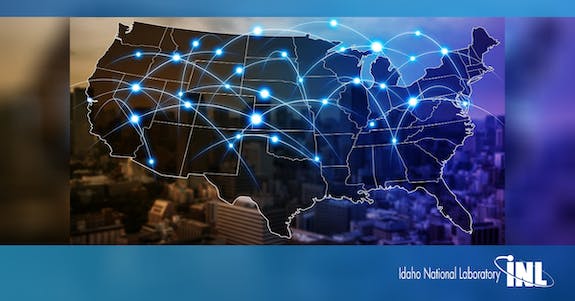Five INL-supported projects included in latest granting session
Since the 1980s, when the U.S. government directed national labs to share their innovations with companies in the private sector, Idaho National Laboratory has viewed technology transfer as a key part of its mission.
Under different contractors, in times of stability and uncertainty, INL researchers and engineers have been encouraged to look for partners that might help in the commercialization of lab-developed technology. Likewise, they are encouraged to keep their eyes open for entrepreneurs who might benefit from their research.
One tool that has long been available is the Small Business Innovation Research (SBIR) program, established by Congress in 1982. Its purpose has been to match small American businesses to federal research and development money and expertise. SBIR was followed by the Small Business Technology Transfer (STTR) program. While SBIR focuses on early-stage technology, STTR’s goal is to pair entrepreneurs with commercialized technology developed by universities and Federally Funded Research and Development Centers (which include DOE’s national laboratories).
INL has been an active participant in SBIR/STTR projects, and the announcement in May of five new grants indicates the pace is picking up, said Jason Stolworthy, who heads the lab’s Technology Deployment Office. “Over the years, we’ve had a lot of impact helping companies develop their technology,” he said.
A textbook example
Out of all the SBIR/STTR projects INL has been involved with, perhaps its relationship with CF Technologies of Hyde Park, Massachusetts, provides the best example of how the process works. CF Tech designs and builds supercritical fluids systems. Supercritical fluids are made when a substance such as CO2 is held at a temperature and level of pressure to behave like a gas but with the density of a liquid. The relatively low temperature and the stability of supercritical CO2 (scCO2) allows most compounds to be extracted with little damage or denaturing. Due to its low toxicity, scCO2 has become a widespread commercial and industrial solvent, used in everything from decaffeinating coffee beans and tea leaves to dry cleaning.
INL research was essential to a $150,000 STTR Phase I grant that CF Tech received in 2016 to use scCO2 to convert “brown grease” found in kitchens, food processing plants and solid waste systems into biodiesel fuel. That was followed in 2017 with a STTR Phase II grant for nearly $1 million, intended to scale the process up.
“STTR has allowed us to get work done that we wouldn’t have been able to do otherwise,” said Dr. Dan Ginosar. He and Dr. Robert Fox have been INL’s principal investigators with CF Tech. Ginosar said the next step could involve responding to a Funding Opportunity Announcement from DOE’s Bioenergy Technologies Office (BETO), but while that continues, CF Tech and INL are now involved in a STTR Phase I project from 2019 using supercritical fluids in the purification of rare earth metals to make a radiopharmaceutical isotope used in detecting and treating stomach tumors. The drug is not produced domestically, and conventional processes result in significant amounts of waste and acidic solvents. CF Tech’s solution is aimed at producing a drug that costs less, uses less energy to make, and produces less waste.
None of this happens overnight. Ginosar said the relationship between CF Tech and INL goes back nearly 20 years, to a conference where Ryan McMurtrey, an INL researcher who has since left the lab, met John Moses, CF Tech’s CEO. “We discovered we have a lot of complementary experience,” Ginosar said.
‘The challenge is the transfer’
When Dynexus Technology of Loveland, Colorado, wanted to test its battery monitoring prototype on a working cellphone tower, it had a hard time finding any commercial takers. A path forward opened up, however, when it learned about INL’s wireless test bed.
“The national laboratories are really a national treasure,” said David Sorum, the company’s president and CEO.
During a demonstration at a communications tower near Experimental Breeder Reactor-I, an INL employee remarked to Dynexus employees that they might be interested in the impedance measurement box developed by the Energy Storage Group. This set the wheels in motion for a December 2016 licensing agreement under which Dynexus is commercializing the technology that can almost instantly analyze a battery cell’s health and stability.
“The real challenge with tech transfer is the transfer,” Sorum said. “The folks at INL have been really great to work with. They’re still very much interested in our success.”
Before any licensing agreement could be reached, intellectual property rights had to be consolidated into the hands of Battelle Energy Alliance, the contractor that runs INL for DOE. That meant finding patent holders, some of whom no longer worked for the lab, and getting them to sign off. Two of the researchers from the Energy Storage Group have since gone to work for Dynexus. “It’s exciting for them to continue with this,” Sorum said. Dynexus’ focus has been on migrating from an analog to a digital device, along with additional size and cost reductions to enable scalability.
Sorum said they have not ruled out pursuing SBIR/STTR funding or an application to DOE’s Technology Commercialization Fund. “We continue to look for opportunities to partner with the lab to develop the technology,” he said.
INL named partner in five SBIR, STTR projects
Here are the five Small Business Innovation Research and Small Business Technology Transfer projects chosen by the U.S. Department of Energy and supported by Idaho National Laboratory research.
Near Infrared Biomass Probe and Deployment Methods for Real-time, Field-Based, Biomass Quality Measurement (EERE)
This Phase I SBIR project involves a near-infrared fiberoptic probe that can make biomass quality measurements of corn stover bales. Near-infrared spectroscopy is a noninvasive technique that uses light transmission and absorption to measure hemoglobin and mitochondrial oxygenation. It is widely applied in agriculture for determining the quality of forages, grains, and grain products. While infrared light can only penetrate about 80 nano-meters (nm) into the solid materials, the probe lets researchers push the working parts of the spectrometer about 60 centimeters into a bale or pile of materials. INL Principal Investigator William Smith is contributing his engineering expertise and market research abilities to Antares Group of Lanham, Maryland. Other partners include Iowa State University; Dr. Bonnie Hames, a biomass consultant in Los Angeles, formerly a research chemist at National Renewable Energy Laboratory; and Dr. John Cundiff, professor emeritus at Virginia Polytechnic Institute.
High Power and High Temperature Heat Pipes for Small and Modular Reactors (NE)
This project involves Advanced Cooling Technologies, a Lancaster, Pennsylvania, company that has developed high-performance wicks for cooling pipes in small modular reactors and microreactors. These wicks show potential to boost the transfer capability of passive heat exchangers by two to four times, which could reduce the number of heat pipes per reactor, and a reactor’s size, complexity, and cost.
With advanced reactor research slated for the National Reactor Innovation Center at INL, “It’s vital that we have a supply chain for heat pipes that can be used for these microreactors,” said Donna Guillen, a co-principal investigator on the project.
Advanced Laser Ultrasonic Sensor for Fuel Rod Characterization
This project involves laser-based, noncontact ultrasound technology being developed by Intelligent Optical Systems, a company based in Torrance, California. “SBIRs are fantastic for working with small companies that have developed very specialized technologies,” said Josh Daw, INL’s principal investigator. While lasers have been widely used to generate and detect ultrasonic waves in materials testing, they have not been used in high radiation nuclear settings. Daw said they anticipate doing tests on surrogate cladding material first, shooting material with one laser and using a second to detect cracks and strains in the material. As they build a path to commercialization, the technology could eventually be used in transient tests.
Advances in Nuclear Plant Physical Security Modeling and Simulation
Working with the ARES Security Corp. of Burlingame, California, INL continues to develop new applications for Event Modeling Risk Assessment Using Linked Diagrams (EMRALD), a software tool for researching capabilities of Probabilistic Risk Assessment. Current physical security simulation does not include changes in plant status that could impact margin to failure. INL Principal Investigator Steven Prescott will consult with ARES staff about incorporating plant modeling and simulation into physical security response plans.
Advanced Simulation-based 3D Framework and Toolkit for Fire Protection and Probabilistic Risk Analysis
This STTR project, also helmed on INL’s end by Steven Prescott, represents an enhancement to the INL-developed Fire Risk Investigation in 3D (FRI3D) platform. Because of the complexity of fire phenomena and multiple operational procedures, fire analysis in a nuclear power station is costly and labor-intensive. Using current analysis methods, it is difficult to computationally provide assurance that mitigation methods are adequate for critical areas. The FRI3D software consists of two main parts: an application program interface back end with the logical fire model, and a graphical program interface with a 3D viewing front end. This combination allows users to develop and see spatial relationships along with existing fire models. INL is partnering with Centroid LAB of Los Angeles, a software consultancy firm providing support and analysis for Fluid Simulation and Visualization.
How SBIR/STTR programs work
Each year, federal agencies with R&D budgets over $100 million are required to direct 3.2% of that money to small businesses through the SBIR program. Federal agencies with extramural R&D budgets that exceed $1 billion are required to reserve 0.45% for the STTR program. Including the U.S. Department of Energy, 11 federal agencies participate in SBIR and five participate in STTR. Each year these agencies designate R&D topics in their solicitations and accept proposals from small businesses. Awards are made after all proposals have been competitively evaluated.
The SBIR program is structured with three gated phases. Depending on the agency, a Phase I award is typically six to nine months and around $150,000. Phase I typically involves research and possibly prototyping to prove feasibility of the initial proposal. At the conclusion of Phase I, the participating small business may be asked to submit a Phase II proposal. Phase II awards are typically for about two years and $1 million in total funding.
Phase III is when a small business successfully commercializes the technology. Securing Phase III status indicates that the government made a successful investment. Phase IIIs are not funded with SBIR money—funding is provided by the “programs of record” that are procuring the technology or service.
To be eligible for participation, a small business must have fewer than 500 employees, be American-owned and organized as a for-profit entity.







